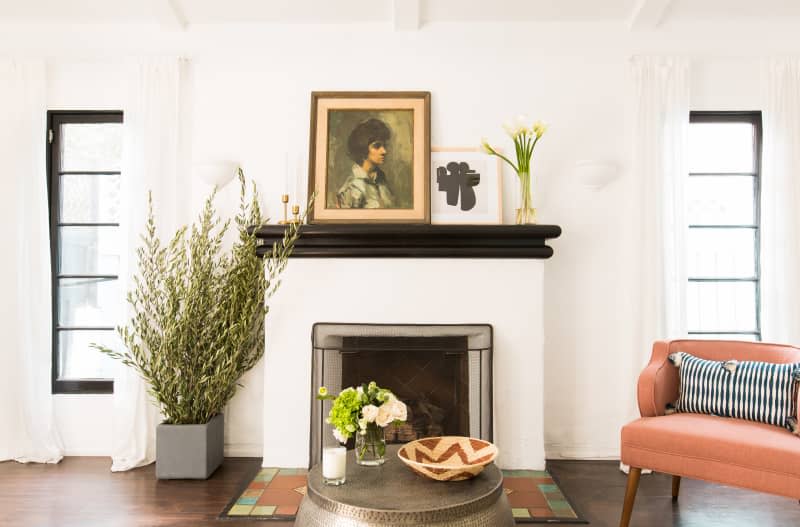This Cozy "Keeping Room" Trend Is Making a Comeback (You'll Want Your Own!)

It’s no secret that home trends come and go. Everything that’s old becomes new again — especially in real estate. Perhaps popcorn ceilings will even make a comeback one day, but for now the trend that’s starting to pop up is keeping rooms. But what is a keeping room, and why might you want one? Read on to find out.
A History of the Keeping Room
Keeping rooms have been around since the early 1700s, but are commonly associated with the American Colonial era, says design historian Maile Pingel. “Historically, a keeping room was a ground-floor room adjacent to the kitchen so that it benefited from the warmth of the large, open hearth where meals were prepared,” says Pingel. “In smaller or more rural homes, the kitchen was often the only heated space.”
Because of their close proximity to the kitchen, keeping rooms were the perfect place to gather and “keep” warm while staying out of the cook’s way. Keeping rooms also often featured a fireplace for added warmth. Because people often spent all day in the keeping room, they had plenty of time to complete other small tasks and hobbies like reading, writing, and sewing. They could also provide company to the cook as they went about their day.
“Keeping rooms were simple but comfortable multi-purpose spaces that might offer cupboards for storage; a space-saving drop-leaf table for food prep, meals, or mending; a cradle; chairs for conversation or reading — some even had beds,” Pingel explains. The keeping room accommodated all aspects of daily life — and with multigenerational homes, they were probably crowded at times, with the whole family huddling for warmth.
According to Pingel, keepings rooms fell out of use sometime in the second half of the 19th century, as the middle class grew and began to gravitate towards more formal reception rooms. These were clearly spaces made for gathering, much like the modern-day living room. They were separated from the cluttered kitchen, which became a more clearly defined workspace for whoever cooked in the house, rather than the center of family life.
How to Identify a Keeping Room
If you own a colonial-era home (or are looking to buy one), you might run across an original keeping room — especially if you’re in the South and Northeast United States, where there is an abundance of colonial architecture. There are some easy ways to identify it.
One of the most important distinctions of a keeping room (versus a den, dining room, or living room) is its proximity to the kitchen. The primary purpose of a modern-day keeping room is to keep someone in the kitchen company without overcrowding it, so the space is always either attached to or off of the kitchen itself. It might also feature a fireplace, some sort of cabinet or storage area, or built-in seating.
Modern-Day Keeping Rooms
Keeping rooms are beginning to show up again in some new-construction homes, too. “With their comeback today, keeping rooms are again embracing the warmth and convivial nature of the kitchen, but this time around there’s a greater emphasis on comfort,” Pingel says. “Not unlike the British snug, today’s keeping rooms tend to be cozy and quiet, television-free zones.”
If you’re currently looking at new-construction homes, you might be drawn to open floor plan kitchens, which sometimes have a large central island where people can sit while someone is cooking dinner.
However, you might want to consider a build with a keeping room, which would offer more comfort than barstools and opportunities for customization. Present-day keeping rooms don’t need to have a fireplace, thanks to HVAC systems, although you might want to include one for enjoyment and extra warmth.
You can also furnish a keeping room with comfortable furniture for seating — maybe a small couch or a few chairs — as well as a small table and cozy accents like soft pillows and throw blankets. The goal is to create a warm area where it’s possible to relax and socialize as close to the kitchen as possible without actually being in the kitchen.
Similar to colonial days, keeping rooms can still be multi-purpose spaces. They can be used for hosting cocktail hours and family game nights, or for entertaining guests. To contain clutter, you might want to consider adding a storage cabinet or hutch to hide away books, games, and glassware when not in use.
I Don’t Have a Keeping Room — Now What?
Many homes, of course, do not have dedicated keeping rooms. Luckily, it’s easy to recreate the functions of a keeping room in your home. In fact, you might already have a keeping room in your home without realizing it. Even though it isn’t a full room, a breakfast nook, which provides seating for casual eating and hanging out, can be considered an unofficial keeping room. It’s a versatile space that is often used to keep the cook company while in the kitchen.
To create a keeping room in your home, you just need a few comfy seats and a table for various activities. If you create a cozy area where people want to sit and hang out, it might even become the new favorite gathering space in your home.

